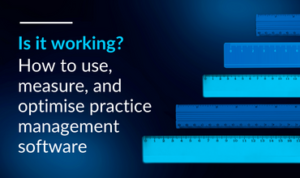How to use, measure, and optimise practice management software
Monday 7 November, 2022
To discuss your requirements for legal software, please click to book an online demo or contact us on 01252 518939 info@insightlegal.co.uk

Monday 7 November, 2022
To discuss your requirements for legal software, please click to book an online demo or contact us on 01252 518939 info@insightlegal.co.uk

If you purchase a limited-edition collection of leather-bound hardbacks, then use them as a doorstop, they might do that job very well, but it’s a shameful waste of potential. If you choose and implement practice management software without understanding how to use, measure, and optimise it, you’re squandering it in much the same way.
Here’s how to get the most out of your legal practice management software.
Your legal practice management software should bring everything together into one system, so that you have full visibility of the business side of the firm.
Performance analysis
Law firms need a view of their performance in macro and in micro. That means they need data on the performance of the practice as a whole, specific departments, and individual fee-earners. That should be visible in reporting and analytical tools, but also ideally in an instantly-available overview report. By gathering performance metrics, partners can make better-informed commercial decisions.
Workflow definition
Especially in the world of hybrid work, it’s not easy for partners to make sure everything’s done the way they want. Even before teams worked remotely, individuals would inevitably have had quirks and preferences that threatened standardised workflows. You can use a practice management solution to guide and maintain processes, even when teams’ working methods aren’t immediately visible.
Control and compliance
Since the regulatory pitfalls for law firms are many and varied, maintaining control and certainty about compliance is essential to the health of the firm. The practice will suffer serious financial and reputational damage from any compliance failures, so using practice management software mean you can prevent GDPR, AML, or conflict of interest breaches with far greater speed and certainty than relying on ‘manual’ checks.
Measure
There’s no question that you need to measure the impact of your practice management tools — the question is how, and there’s no universal answer. Yours will be driven by whatever needs to get better, and what matters to you. It might be any or all of the following, or indeed something else altogether.
Efficiency and productivity
Probably the most obvious measurement for a management tool is the time it saves. Providing you measure it accurately and have precise data on how long tasks and processes used to take, it’s an objective yardstick and a very clear performance indicator.
Revenue
Born of efficiency and productivity, revenue is also a strong numerical indicator. There is always more than one factor at play with revenue growth, of course, so you’ll need to be somewhat scientific. If you start using practice management software and your revenue increases, there’s likely a causal relationship, but you’d want to be more precise than that.
What specifically has caused it? Was it that the firm is more efficient, and so has the capacity for more clients or more billable hours? Was it that you started time recording effectively, so were able to bill more accurately and charge more time? Did you find that the efficiency meant you didn’t need to replace staff who left, and saved money on wages and other employee costs?
Wellbeing
A more abstract but no less important measurement is the wellbeing of partners, fee-earners, and staff. You will have your own sense of whether the tools you use are reducing stress, increasing feelings of control and balance, and improving visibility, and you might even notice a lift in the general mood of the firm.
You then need to dig deeper into that by asking for the team’s assessment of things. That might be casually and face-to-face in passing conversation, or it might be a more formal anonymised survey. Whatever version suits you, you should find out whether and how your tools have made work easier, less stressful, or more fulfilling.
Optimise
One fundamental yet inexplicably overlooked test of a tool is whether it’s easier to use it than not to use it. Business leaders and managers often mandate that people use a certain tool in a certain way, but if it makes working life harder, they’ll eventually use it badly, sporadically, or the bare minimum they can get away with.
If you’re looking to optimise a tool, it’s often less about getting people to use it better, it’s about making it work better for people. Start by understanding how your teams use the software, and if the platform isn’t creating the desired outcome, it may be that there’s a more intuitive way to use it than the method imposed by the firm’s hierarchy.
That’s not to say everyone should use a tool in their own way — you certainly need uniformity, but the setting of that standard should be democratic, not dictatorial. Forcing people to use software in a way that doesn’t suit them will only mean resentment of the platform and ineffective use of it.
One piece of software that has helped over 1,000 firms increase their revenue, efficiency and wellbeing is Insight Legal. One of our clients reported a ‘transformative change in productivity’ and another noted ‘they really listen to their users and include requests and suggestions in the design.’
If you spend just 30 minutes on a demo, you’ll see how your peers are making radical improvements in their practice, and how you could give your teams a productivity tool that they won’t need any persuading to use.
Book yours here.